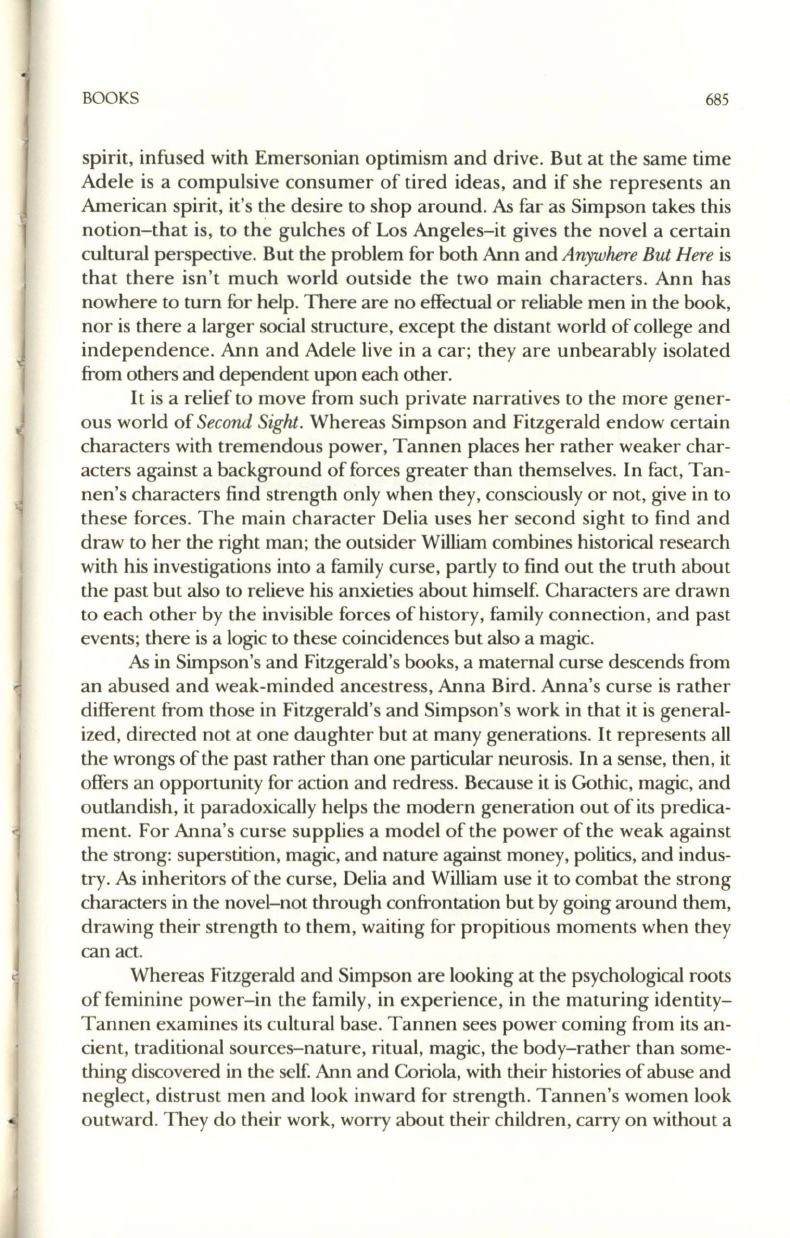
BOOKS
685
spirit, infused with Emersonian optimism and drive. But at the same time
Adele is a compulsive consumer of tired ideas, and if she represents an
American spirit, it's the desire to shop around.
As
far as Simpson takes this
notion-that is, to the gulches of Los Angeles-it gives the novel a certain
cultural perspective. But the problem for both Ann and
Anywhere But Here
is
that there isn't much world outside the two main characters. Ann has
nowhere to turn for help. There are no effectual or reliable men in the book,
nor is there a larger social structure, except the distant world of college and
independence. Ann and Adele live in a car; they are unbearably isolated
from others and dependent upon each other.
It
is a relief to move from such private narratives to the more gener–
ous world of
Secorul Sight.
Whereas Simpson and Fitzgerald endow certain
characters with tremendous power, Tannen places her rather weaker char–
acters against a background of forces greater than themselves. In fact, Tan–
nen's characters find strength only when they, consciously or not, give in to
these forces. The main character Delia uses her second sight to find and
draw to her the right man; the outsider William combines historical research
with his investigations into a family curse, partly to find out the truth about
the past but also to relieve his anxieties about himself. Characters are drawn
to each other by the invisible forces of history, family connection, and past
events; there is a logic to these coincidences but also a magic.
As
in Simpson's and Fitzgerald's books, a maternal curse descends from
an abused and weak-minded ancestress, Anna Bird. Anna's curse is rather
different from those in Fitzgerald's and Simpson's work in that it is general–
ized, directed not at one daughter but at many generations.
It
represents all
the wrongs of the past rather than one particular neurosis. In a sense, then, it
offers an opportunity for action and redress. Because it is Gothic, magic, and
outlandish, it paradoxically helps the modern generation out of its predica–
ment. For Anna's curse supplies a model of the power of the weak against
the strong: superstition, magic, and nature against money, politics, and indus–
try.
As
inheritors ofthe curse, Delia and William use it to combat the strong
characters in the novel-not through confrontation but by going around them,
drawing their strength to them, waiting for propitious moments when they
can act.
Whereas Fitzgerald and Simpson are looking at the psychological roots
offeminine power-in the family, in experience, in the maturing identity–
Tannen examines its cultural base. Tannen sees power coming from its an–
cient, traditional sources-nature, ritual, magic, the body-rather than some–
thing discovered in the self Ann and Coriola, with their histories of abuse and
neglect, distrust men and look inward for strength. Tannen's women look
outward. They do their work, worry about their children, carry on without a


